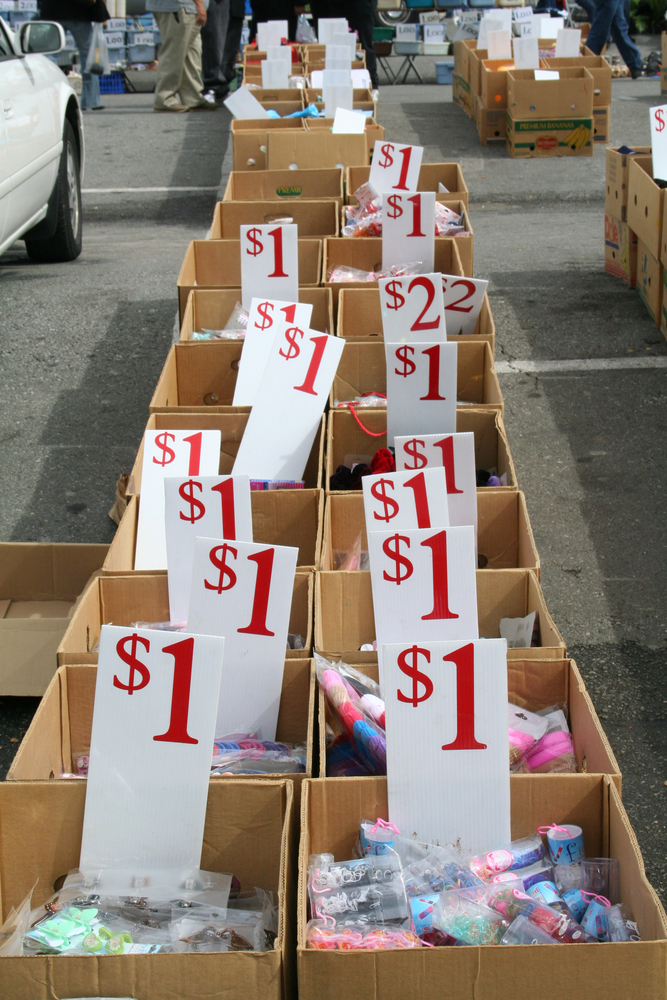February 16, 2024 - Benjamin Ehinger
How to Price Items for a Garage Sale: Setting the Right Value
CALL NOW 844-762-8449
Pricing items for a garage sale effectively is crucial for a successful event. It involves a fine balance between attracting buyers with deals and ensuring you don’t undersell valuable items. To set the right prices, you need to consider the original value of your items, their current condition, and general pricing guidelines that suggest pricing garage sale items at roughly 10% of their retail price for well-worn items, with higher percentages for those in better condition. Remember, the ultimate goal is to clear out unwanted items while making some money, so it’s important to be realistic and flexible with pricing.
As you prepare for your garage sale, think about the presentation and how it affects sales. Clearly priced items with visible tags can help customers make quick decisions, and having a pricing strategy for popular categories can streamline the process. Consider creating a bargaining policy and be ready to adjust prices as the sale goes on to maximize sales. After the sale, plan for unsold items, perhaps by getting a small dumpster rental to dispose of any unwanted pieces to ensure a clean and clutter-free space.
 When preparing items for your garage sale, it’s essential to conduct thorough research on each item’s current market value. Start by exploring online marketplaces to find comparable items and their going rates. This groundwork not only helps establish a baseline but also informs you of the demand for certain items.
Consider a pricing strategy that reflects the condition and desirability of your goods. One approach is the 10% rule, which suggests setting prices at roughly 10% of the retail value. However, be ready to adjust based on the item’s wear and uniqueness.
Emphasize simplicity in your pricing for the ease of transaction. Stick to price increments that don’t require complicated change, like 25 or 50 cents, or whole dollar amounts for smoother sales, as advised in this quick guide.
Flexibility is key. Garage sales are known for bargains, so be prepared to negotiate. When multiple items are involved, offer a better deal:
When preparing items for your garage sale, it’s essential to conduct thorough research on each item’s current market value. Start by exploring online marketplaces to find comparable items and their going rates. This groundwork not only helps establish a baseline but also informs you of the demand for certain items.
Consider a pricing strategy that reflects the condition and desirability of your goods. One approach is the 10% rule, which suggests setting prices at roughly 10% of the retail value. However, be ready to adjust based on the item’s wear and uniqueness.
Emphasize simplicity in your pricing for the ease of transaction. Stick to price increments that don’t require complicated change, like 25 or 50 cents, or whole dollar amounts for smoother sales, as advised in this quick guide.
Flexibility is key. Garage sales are known for bargains, so be prepared to negotiate. When multiple items are involved, offer a better deal:
Remember, transparency about condition and readiness to discount will make your garage sale a success.
 When you’re setting up your garage sale, it’s important to have a bargaining policy in place. This will help you manage expectations and keep transactions smooth.
When you’re setting up your garage sale, it’s important to have a bargaining policy in place. This will help you manage expectations and keep transactions smooth.
Using this approach, you keep the sale dynamic and give shoppers the sense they are getting a better deal as the day goes on, which makes them more likely to buy. Remember, the goal is to sell items, not necessarily to get the highest price for each one.
Key Takeaways
- Set garage sale prices based on item condition and retail value.
- Use clear pricing labels and have a strategy for different item categories.
- Plan for unsold items with a post-sale disposal method such as dumpster rental.
Setting Your Garage Sale Goals
Before pricing your garage sale items, identify what you’re hoping to achieve. Your goal will significantly influence how you price items and can range from decluttering to maximizing profit.- Decluttering: If your primary goal is to clear out space, you might price items lower to encourage quick sales. Your priority is to see items leave rather than to make large amounts of money.
- Earning Money: Should your focus be on making a profit, consider pricing items higher, but remain realistic about their second-hand value. Remember that garage sale shoppers are looking for deals.
- Community Engagement: Some hold garage sales to interact with neighbors or provide affordable items to the community. In such cases, you might adopt a more flexible pricing approach to foster goodwill.
- Item Condition: Newer and gently used items can command higher prices.
- Item Demand: High-demand items may warrant a slightly higher price point.
- Time Investment: If you want a fast sale, price items to sell quickly.
- Set a clear goal.
- Understand your merchandise value.
- Be prepared to negotiate.
Understanding the Value of Your Items
When organizing a garage sale, accurately pricing your items is crucial for a successful event. Start by assessing the condition of each piece—whether it’s furniture, gadgets, or clothing—as this significantly impacts value. Items in excellent or like-new condition can fetch a higher price, whereas well-worn objects should be priced more modestly. Here’s a simple guideline on how to gauge the worth of your items:- Like-new: up to 50% of the original retail price
- Good condition: 25%-30% of the original retail price
- Fair or worn: 10%-15% of the original retail price
- Books: Hardcovers can often be sold for $1 each, with paperbacks at two for $1. Providing variety bundles can also attract more buyers.
- Entertainment: DVDs and Blu-rays might go for $1 for older titles and $2 for newer ones, while CDs could be two for $1.
- Tech: Price electronics like TVs or computer screens between $50 to $100, but be prepared to adjust based on age and demand.
- Clothing: Brand-name apparel in good condition can range from $5 to $15; however, everyday wear should be less.
Research and Pricing Strategy
 When preparing items for your garage sale, it’s essential to conduct thorough research on each item’s current market value. Start by exploring online marketplaces to find comparable items and their going rates. This groundwork not only helps establish a baseline but also informs you of the demand for certain items.
Consider a pricing strategy that reflects the condition and desirability of your goods. One approach is the 10% rule, which suggests setting prices at roughly 10% of the retail value. However, be ready to adjust based on the item’s wear and uniqueness.
Emphasize simplicity in your pricing for the ease of transaction. Stick to price increments that don’t require complicated change, like 25 or 50 cents, or whole dollar amounts for smoother sales, as advised in this quick guide.
Flexibility is key. Garage sales are known for bargains, so be prepared to negotiate. When multiple items are involved, offer a better deal:
When preparing items for your garage sale, it’s essential to conduct thorough research on each item’s current market value. Start by exploring online marketplaces to find comparable items and their going rates. This groundwork not only helps establish a baseline but also informs you of the demand for certain items.
Consider a pricing strategy that reflects the condition and desirability of your goods. One approach is the 10% rule, which suggests setting prices at roughly 10% of the retail value. However, be ready to adjust based on the item’s wear and uniqueness.
Emphasize simplicity in your pricing for the ease of transaction. Stick to price increments that don’t require complicated change, like 25 or 50 cents, or whole dollar amounts for smoother sales, as advised in this quick guide.
Flexibility is key. Garage sales are known for bargains, so be prepared to negotiate. When multiple items are involved, offer a better deal:
- Single item: Stick closer to the 10% rule.
- Multiple items: Consider a bundle price to incentivize buyers.
| Item Category | Example | Starting Price Range |
|---|---|---|
| Clothing | T-shirt | $1-$3 |
| Electronics | DVD player | $5-$15 |
| Home Decor | Picture Frame | $2-$5 |
| Tools | Hammer | $3-$7 |
| Toys | Board Games | $2-$6 |
Presenting Your Items
When preparing for a garage sale, how you present your items can significantly influence sales. Clean and well-displayed items not only attract buyers but can also justify your pricing.Cleaning and Repair
Ensure each item is clean—a quick wipe can make a product more appealing. Check for and conduct minor repairs; functionality can be a selling point. For example, sew loose buttons on clothing or tighten screws on furniture pieces.Display and Accessibility
Strategically arrange items to maximize visibility and access. Use tables to elevate goods and group similar items together, like books or kitchenware. Ensure that all items are easily reachable, with paths clear for comfortable browsing.Pricing Popular Item Categories
When hosting a garage sale, setting the right price point for various categories can help you sell more efficiently. Here’s how to price some of the most common items.Clothing and Apparel
Gently used brand-name clothing can be priced at $5 to $15. Items in excellent or like-new condition could command around 50% of their original retail price. For clothing that’s well-worn but still in good shape, aim for 25%-30% of the initial price.Electronics and Appliances
Price smaller electronics and appliances like toasters or DVD players between $3 and $15, depending on age and condition. Pricier tech items like smart home devices or TVs might go for $50 to $100. Always consider the item’s initial cost and functionality when pricing.Furniture and Large Items
For furniture, you can start at approximately 30% to 50% of the original price if it’s in good condition. Large items that are bulky or hard to move should have prices that reflect their convenience factor, as it may be harder to find a buyer.Toys and Games
Open toys and games, if complete and in good condition, can typically be priced around $1 to $5. Collectible or never-opened items could be priced higher, usually 20%-30% of their original price, depending on their rarity and demand.Books and Media
Hardcover books can be sold for about $1 each, with paperbacks going two for $1. CDs might be priced at two for $1, while DVDs and Blu-rays can range from $1 to $3, depending on their age and popularity. Prices could be adjusted based on content and edition rarity.Using Price Tags and Labels
When organizing a garage sale, effective use of price tags and labels is crucial for displaying prices clearly. By doing so, you make it easier for customers to make purchasing decisions, which can lead to better sales. Begin by selecting the right type of tag for your items. For objects that can be damaged by adhesive, such as books or collectibles, use tie-on tags. These allow you to affix prices securely without leaving residue or causing harm. For other items, standard sticker labels may suffice. When creating labels, consider the following format to ensure clarity:- Item Description: Briefly describe the item.
- Price: Clearly mark the price.
- Negotiable: Indicate if the price is fixed or open to offers.
- Under $1: Use for smaller items or those with significant wear.
- $1 – $5: Good for common household goods and books.
- $5 – $20: Ideal for electronics, small appliances, and furniture in good condition.
- Place all $1 items together on one table.
- Hang clothing of the same price in one section.
Creating a Bargaining Policy
 When you’re setting up your garage sale, it’s important to have a bargaining policy in place. This will help you manage expectations and keep transactions smooth.
When you’re setting up your garage sale, it’s important to have a bargaining policy in place. This will help you manage expectations and keep transactions smooth.
- Pre-Price with Flexibility: Begin by pricing your items clearly with visible labels. However, be mentally prepared for negotiation. Remember, garage sale enthusiasts often look for deals and enjoy the process of haggling.
- Decide on Minimum Prices: Before the sale, determine the minimum amount you’re willing to accept for each item. This will help you negotiate confidently and avoid indecision during the sale.
- Bulk Purchase Incentives: Encourage buyers to purchase more by offering discounts on bulk purchases. For example, if someone is interested in several books, consider reducing the price for a bundle.
| Item | Single Item Price | Bundle of 3+ | Minimum Price |
|---|---|---|---|
| Books | $1.00 each | $0.75 each | $0.50 each |
| DVDs | $2.00 each | $1.50 each | $1.00 each |
| Clothing | $3.00 each | $2.00 each | $1.00 each |
- Stay Calm and Polite: Always negotiate with a smile. Even if you decline an offer, do it politely. A good atmosphere can often lead to a sale later on.
- Know When to Hold Firm: It’s okay to stand firm on your prices for items that you believe are worth more. If buyers see that you have knowledge of an item’s value, they may be more inclined to agree to your price.
Promotion and Advertising Prices
When preparing for your garage sale, your item pricing should reflect not only the value of the goods but also the need to attract buyers. Efficient promotion and advertising are pivotal in drawing attention to your sale. Create Eye-Catching Signage:- Make sure signs are readable from a distance.
- Use bold colors and large fonts.
- Briefly list the types of items for sale (e.g., Furniture, Books, Clothes).
- Utilize local community forums, social media groups, and classified websites.
- Highlight key items with attractive pricing to pique interest.
- Bundle Deals: Offer discounts for purchasing multiple items.
- Early Bird Specials: Reduce prices by a small percentage for the first few hours.
- Distribute in local stores (with permission), community centers, and busy areas.
- List select items with ‘special offer’ prices to encourage early visits.
Managing Price Adjustments During the Sale
When hosting a garage sale, being flexible with pricing can lead to more sales and less leftover items. It’s essential to monitor the interest level of shoppers and adjust prices accordingly. Initial Pricing: Start with clear, reasonable prices. Use simple pricing increments such as $0.25, $0.50, or whole dollar amounts to make transactions smoother. Time-based Reductions: Plan for price drops as the sale progresses. For example, in the last hour, consider marking items down by 25% to 50%. Make sure to prepare signage in advance to announce these reductions to your shoppers.- Morning: Full price
- Midday: 10-20% off
- End of Sale: 25-50% off
| Time | Strategy | Example |
|---|---|---|
| Morning | Stand firm on prices | $5 per item |
| Midday | Slight discounts | $4 per item |
| Late Afternoon | Bundle deals, reductions | $3 per item or 2 for $5 |
Post-Sale Item Disposal
After your garage sale, you will likely have items that didn’t sell. Proper disposal of these items is important to avoid clutter and waste. Donate: Reach out to local charities or second-hand stores. Many organizations will welcome your unsold items, especially clothing, books, and furniture. Check if they offer pick-up services to make donation easier for you.- List of charitable categories:
- Clothing and Accessories
- Kitchenware
- Toys and Games
- Electronics
- Materials often recycled:
- Paper
- Glass
- Metal
- Plastic
Frequently Asked Questions
When preparing for a garage sale, setting the right prices and finding appropriate tools can make a significant difference. This section answers common questions to help you strategize and achieve a successful sale.What are the best strategies for setting prices on garage sale items?
To optimize your garage sale pricing, consider the item’s condition and original retail price. Items in excellent condition can be priced at 50% of retail, while good conditions might be closer to 25%-30%. Sticking to the ten percent rule is a common strategy, where you don’t charge more than 10% of the retail price.Why should I use a dumpster rental to dispose of items after my garage sale?
A dumpster rental can simplify the disposal process for unsold items, especially if they’re bulky or numerous. It allows you to clear out remaining clutter immediately after your sale, ensuring your space is clean and organized without multiple trips to the dump.Where can I find a printable pricing guide for organizing my garage sale?
Printable pricing guides are readily available online and can assist in maintaining consistency with your pricing. Websites like Real Simple offer handy garage sale pricing guides that you can use as a reference.Are there any recommended price lists for commonly sold items at garage sales?
Yes, there are suggested price lists which can serve as a starting point for common garage sale items. These can be found on garage sale-specific websites and typically list a range of items you may want to sell.How can I efficiently label and tag items for sale in my garage?
For efficient labeling, use bright-colored stickers and a clear marker to write prices. Consider pre-printed price labels for popular price points, and group items of the same price together to make shopping easier for your customers.What tips can you provide for pricing items competitively while ensuring profitability?
Price items with a little room for bargaining, and be willing to reduce prices toward the end of the sale. Competitive pricing means being fair, so keep your prices low enough to attract buyers but enough to reflect the item’s value.Which apps or tools are useful for pricing items at a garage sale?
There are several apps and online tools that can help you with pricing items. These tools often come with features that let you scan barcodes or input descriptions to estimate current second-hand market values.RECENT BLOGS
Our Reviews
Glenda Lanier Prowell
1721758635
I have ordered an 11 yard dumpster to be delivered to my house.Lonier was extremely helpful and answered all my questions. The rate was very reasonable.
Cedric Smikle
1721660395
Amber was extremely professional and courteous. She answered all of my questions and even some that I didn’t know I needed to ask.
Cait Kaider
1721243051
I highly recommend Waste Removal USA for their responsiveness and how the staff work hard to provide exceptional customer service. They have done well by us and our clients. Thank you!
Easom Family
1721223306
Louiner Pierre-Louis Is awesome! Did a great job. Will definitely be using this same company for all my dumpster needs because of his awesome customer service! Thank you!!!
tabitha Vazquez
1720539988
Wonderful and fast customer service!
LATEST BLOGS






